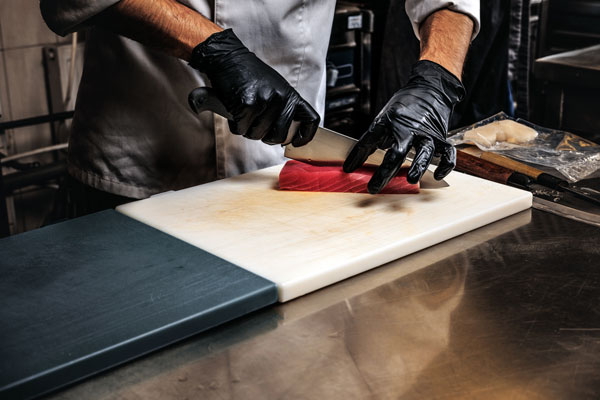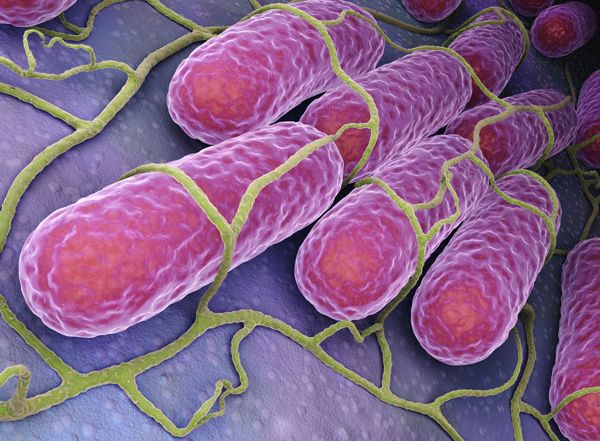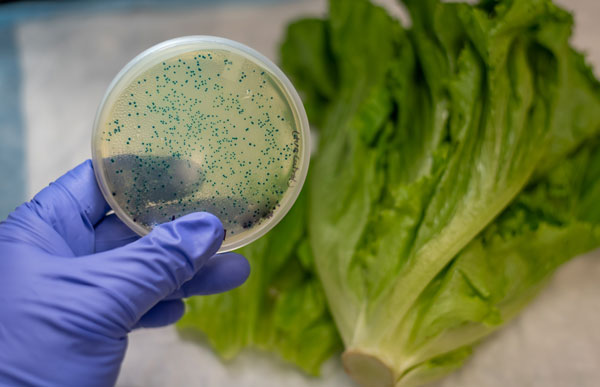Handling Leafy Green Salad
 We have had several produce outbreaks of foodborne disease from our lettuce, spinach, and other greens in the last several years that have been devastating to the produce growers and distributors, retail grocery stores, restaurants, and consumers.
We have had several produce outbreaks of foodborne disease from our lettuce, spinach, and other greens in the last several years that have been devastating to the produce growers and distributors, retail grocery stores, restaurants, and consumers.
Scientists know we have several environmental challenges at the grower and packer level for produce of all kinds – from wild animal fecal contamination in the fields to infected food handlers. Constant efforts to put in place and enforce use of safer “good agricultural practices” (GAP) are underway. Foodborne disease organisms that have been identified for produce are the usual suspects and include forms of Salmonella, E.coli, Listeria monocytogenes, Staph, Hepatitis A, Norovirus, and others. Some, like E.coli take a very low dose to make someone sick. We have the most concern over what is referred to as “fresh-cut” fruits and vegetables that we as consumers expect to be safe to eat out of the bag or container.
The Lettuce / Greens Washing Concerns —With the increased news media coverage surrounding these outbreaks, people often ask about the best way to wash or re-wash produce in order to decrease the risk of harmful organisms that might be on the food. Bulk leafy greens, whole heads, and other bulk produce with edible skin and skin of melons does need washing at restaurant / consumer level. Does bagged ready-to-eat lettuce and greens need re-washing? Should you use just water, chlorine, commercial antimicrobial produce wash solutions, vinegar, lemon juice, a soft brush, or no wash at all?
At the end user level, does washing of ready-to-eat fresh-cut produce such as leafy greens, immediately before consumption significantly enhance, reduce or have no effect on the risk of foodborne illness? A study was published in Food Protection Trends* with some well-educated insight into the subject. The work of several previous studies was used to help with the conclusions explained below.
The Produce Experts say–The panel of 13 scientists with expertise in microbial safety of fresh produce reviewed the research and re-evaluated guidelines for food service & restaurant operators, regulatory agencies overseeing food facilities, and consumers for handling pre-washed bagged salads. The panel concluded:
– Leafy green salads in sealed bags labeled “washed” or “ready-to-eat” that are produced in a facility inspected by a regulatory authority and operated under “Good Manufacturing Practices” does not need additional washing at the time of use unless specially directed on the label.
– Additional washing of ready-to-eat green salads is not likely to enhance safety. The risk of cross-contamination from food handlers and food contact surfaces used during washing may outweigh any safety benefit that further washing may do.
The Leaf Nooks & Crannies– Another interesting point noted about how pathogenic organism cells attach themselves to leafy greens. If E.coli 0157:H7 is present on the surface of lettuce/leafy greens, it may not be completely eliminated by washing. This is because microorganisms adhere to the surface of produce and may be present in nooks and crannies where water and wash water disinfectants cannot penetrate. Microorganisms have a greater affinity to adhere to cut surfaces than uncut surfaces. So, washing ready-to-eat lettuce and leafy greens products during fresh-cut processing is necessary but does not imply that fresh cut produce is free of microbes.
Study Recommendations to Retail and Food Service Operators regarding rewashing ready-to-eat lettuce/leafy green salads:
– Carefully read labels to determine whether a product is a raw agricultural commodity (e.g. hearts of Romaine) that should be washed before consumption or a ready-to-eat (RTE) food product (e.g. pre-washed lettuce/leafy green salad). If the product is not labeled “washed”, “triple washed” or “ready-to-eat”, the product needs to be washed before consumption.
– If a RTE lettuce/leafy green salad is received in sealed bags labeled “washed”, “triple washed” or “ready-to-eat” from a facility inspected by a regulatory authority and operated under GMPs, it does not need additional washing at the time of use unless specifically directed on the label.
– Current research suggests that if harmful microorganisms are present after commercial washing treatments, they are likely to resist removal or inactivation by further washing.
– If appropriate practices are not followed, there is a risk of cross contamination from food handlers and food-contact surfaces such as sinks, colanders and pans used during washing. This may outweigh any safety benefit that further washing may confer in bagged, pre-washed, RTE salads.
If the end-user chooses to wash the RTE lettuce/leafy green salads before use:
– Wash hands thoroughly with soap and warm water before handling RTE lettuce/leafy green salads. Rewash hands as necessary.
– Clean and sanitize the sink, colander, and any equipment or utensils that will contact the product.
– Use cold running water to wash RTE lettuce/leafy green salads to reduce the potential for cross contamination.
– If product is soaked, reduce the potential for cross contamination by using a registered (US EPA, US FDA, state and local jurisdictions) and appropriately labeled antimicrobial products as per manufacturer’s directions. Antimicrobial concentrations should be monitored to ensure appropriate concentrations are maintained during soaking or washing. Household bleach is generally not acceptable for this application.
Additional considerations:
– Wash hands thoroughly for 20 seconds with soap and warm water before handling RTE lettuce/leafy green salads. Rewash hands as necessary.
– Use a barrier such as clean, intact gloves and/or an appropriate clean and sanitized utensil (changed with sufficient frequency to prevent cross contamination) to handle or dispense fresh-cut lettuce/leafy green salads. This does not alleviate the need for proper hand-washing, so hands should be washed for 20 seconds before gloves are used.
– RTE lettuce/leaf green salads should be shipped, stored and displayed under refrigeration. RTE lettuce/leafy green salad shipping containers may become contaminated during transport and storage. Therefore:
– Inspect product cartons or bags upon receipt and reject any product that shows evidence of mishandling or tampering (e.g., dirty, wet, open or crushed boxes or bags, etc.).
– Ensure that storage practices do not subject the product to potential cross contamination (e.g., do not store raw meats above RTE lettuce/leafy green salad cartons or bags).
– Discard the product if it appears spoiled or has exceeded its labeled use-by date.
Bottom Line: Lettuce and greens are a staple food and fresh-cut fruit and vegetable sales in North America have grown to $15billion per year and don’t expect that to decrease, even given the number of outbreaks. The Food & Drug Administration will pay close attention to this study, so make certain your salad preparers are aware of the 5 points above, read the bag labels, and talk to your produce suppliers.
***
About the Author: Lacie Thrall

This information is provided as a general guideline and is not intended to be, nor does it, constitute legal or regulatory advice. Additional Federal regulations may apply to your particular circumstances. State, regional and local laws, ordinances and regulations may also apply.
READ MORE POSTS
Don’t Turn a Blind Eye to Your Food Defense Practices
Late last week, as I mindlessly scrolled through Twitter, I ran across a Tweet suggesting the #IceCreamChallenge from summer 2019 was the real cause of the Coronavirus spread. Of course, the Tweet was made tongue in cheek, but it did cause me to reflect on that challenge, which had a short life on social media in the summer of 2019.
Salmonella and Listeria monocytogenes: Serious Threats to the Safety of Food
Earlier in the month, I mentioned the top microbial enemies we all face in foodservice operations, E. coli, Campylobacter, Salmonella, and Listeria monocytogenes. While we discussed E. coli and Campylobacter, we did not get around to discussing Salmonella or Listeria monocytogenes.
E. coli, Campylobacter, Salmonella, and Listeria monocytogenes…oh my!
Last month, I blogged a bit about the human factor in food safety. In the foodservice management realm, I do think the human factor is our biggest challenge, day in, day out. While the human factor is a major contributor to most foodborne illness outbreaks, we can’t forget about the microbial enemy we face on a daily basis.
The Human Factor and Food Safety
A few weeks ago, we discussed the top five causes of foodborne illness, 1) Improper hot/cold holding temperatures of time and temperature control for safety foods; 2) Improper cooking temperatures of food; 3) Dirty and/or contaminated utensils and equipment; 4) Poor employee health and hygiene; and 5) Food from unsafe sources. As I noted, all of these items are not in the direct control of your staff, but most can be. For the second blog this month, I wanted to discuss a bit more about the human factor in our food safety programs.










